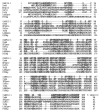Molecular cloning and characterization of an antigenic protein with a repeating region from Clonorchis sinensis
- PMID: 11301591
- PMCID: PMC2721066
- DOI: 10.3347/kjp.2001.39.1.57
Molecular cloning and characterization of an antigenic protein with a repeating region from Clonorchis sinensis
Abstract
In the course of immunoscreening of Clonorchis sinensis cDNA library, a cDNA CsRP12 containing a tandem repeat was isolated. The cDNA CsRP12 encodes two putative peptides of open reading frames (ORFs) 1 and 2 (CsRP12-1 and -2). The repetitive region is composed of 15 repeats of 10 amino acids. Of the two putative peptides, CsRP12-1 was proline-rich and found to have homologues in several organisms. Recombinant proteins of the putative peptides were bacterially produced and purified by an affinity chromatography. Recombinant CsRP12-1 protein was recognized by sera of clonorchiasis patients and experimental rabbits, but recombinant CsRP12-2 was not. One of the putative peptide, CsRP12-1, is designated CsPRA, proline-rich antigen of C. sinensis. Both the C-termini of CsRP12-1 and -2 were bacterially produced and analysed to show no antigenicity. Recombinant CsPRA protein showed high sensitivity and specificity. In experimental rabbits, IgG antibodies to CsPRA was produced between 4 and 8 weeks after the infection and decreased thereafter over one year. These results indicate that CsPRA is equivalent to a natural protein and a useful antigenic protein for serodiagnosis of human clonorchiasis.
Figures






Similar articles
-
[Molecular cloning and characterization of a novel Clonorchis sinensis antigenic protein containing tandem repeat sequences].Zhongguo Ji Sheng Chong Xue Yu Ji Sheng Chong Bing Za Zhi. 2013 Aug;31(4):245-50. Zhongguo Ji Sheng Chong Xue Yu Ji Sheng Chong Bing Za Zhi. 2013. PMID: 24812871 Chinese.
-
[Cloning, expression of PPMP antigen genes of Clonorchis sinensis and immunogenic identification of the recombinant proteins].Zhongguo Ji Sheng Chong Xue Yu Ji Sheng Chong Bing Za Zhi. 2010 Dec 30;28(6):401-5. Zhongguo Ji Sheng Chong Xue Yu Ji Sheng Chong Bing Za Zhi. 2010. PMID: 21500524 Chinese.
-
Immunodiagnosis of clonorchiasis using a recombinant antigen.Korean J Parasitol. 1998 Sep;36(3):183-90. doi: 10.3347/kjp.1998.36.3.183. Korean J Parasitol. 1998. PMID: 9755589 Free PMC article.
-
Molecular cloning and identification of a novel Clonorchis sinensis gene encoding a tegumental protein.Parasitol Res. 2007 Aug;101(3):737-42. doi: 10.1007/s00436-007-0541-8. Epub 2007 May 3. Parasitol Res. 2007. PMID: 17476530
-
[Purification of Clonorchis sinensis native protein and their application in immunodiagnosis of clonorchiasis].Zhongguo Xue Xi Chong Bing Fang Zhi Za Zhi. 2011 Apr;23(2):221-4. Zhongguo Xue Xi Chong Bing Fang Zhi Za Zhi. 2011. PMID: 22164637 Review. Chinese.
Cited by
-
Functional genes and proteins of Clonorchis sinensis.Korean J Parasitol. 2009 Oct;47 Suppl(Suppl):S59-68. doi: 10.3347/kjp.2009.47.S.S59. Korean J Parasitol. 2009. PMID: 19885336 Free PMC article. Review.
-
Human antibody response to thioredoxin peroxidase-1 and tandem repeat proteins as immunodiagnostic antigen candidates for Schistosoma japonicum infection.Am J Trop Med Hyg. 2011 Oct;85(4):674-9. doi: 10.4269/ajtmh.2011.11-0245. Am J Trop Med Hyg. 2011. PMID: 21976571 Free PMC article.
-
Development of "-omics" research in Schistosoma spp. and -omics-based new diagnostic tools for schistosomiasis.Front Microbiol. 2014 Jun 26;5:313. doi: 10.3389/fmicb.2014.00313. eCollection 2014. Front Microbiol. 2014. PMID: 25018752 Free PMC article. Review.
-
Cs1, a Clonorchis sinensis-derived serodiagnostic antigen containing tandem repeats and a signal peptide.PLoS Negl Trop Dis. 2018 Aug 2;12(8):e0006683. doi: 10.1371/journal.pntd.0006683. eCollection 2018 Aug. PLoS Negl Trop Dis. 2018. PMID: 30070987 Free PMC article.
-
Molecular and Structural Characterization of the Tegumental 20.6-kDa Protein in Clonorchis sinensis as a Potential Druggable Target.Int J Mol Sci. 2017 Mar 4;18(3):557. doi: 10.3390/ijms18030557. Int J Mol Sci. 2017. PMID: 28273846 Free PMC article.
References
-
- Banic DM, de Oliveira-Ferreira J, Pratt-Riccio LR, et al. Immune response and lack of immune response to Plasmodium falciparum P126 antigen and its amino-terminal repeat in malaria-infected humans. Am J Trop Med Hyg. 1998;58:768–774. - PubMed
-
- Brosius J, Tiedge H. Reverse transcriptase: mediator of genomic plasticity. Virus Genes. 1995;11:163–179. - PubMed
-
- Brown H, Kemp DJ, Barzaga N, Brown GV, Anders RF, Coppel RL. Sequence variation in S-antigen genes of Plasmodium falciparum. Mol Biol Med. 1987;4:365–376. - PubMed
Publication types
MeSH terms
Substances
LinkOut - more resources
Full Text Sources

